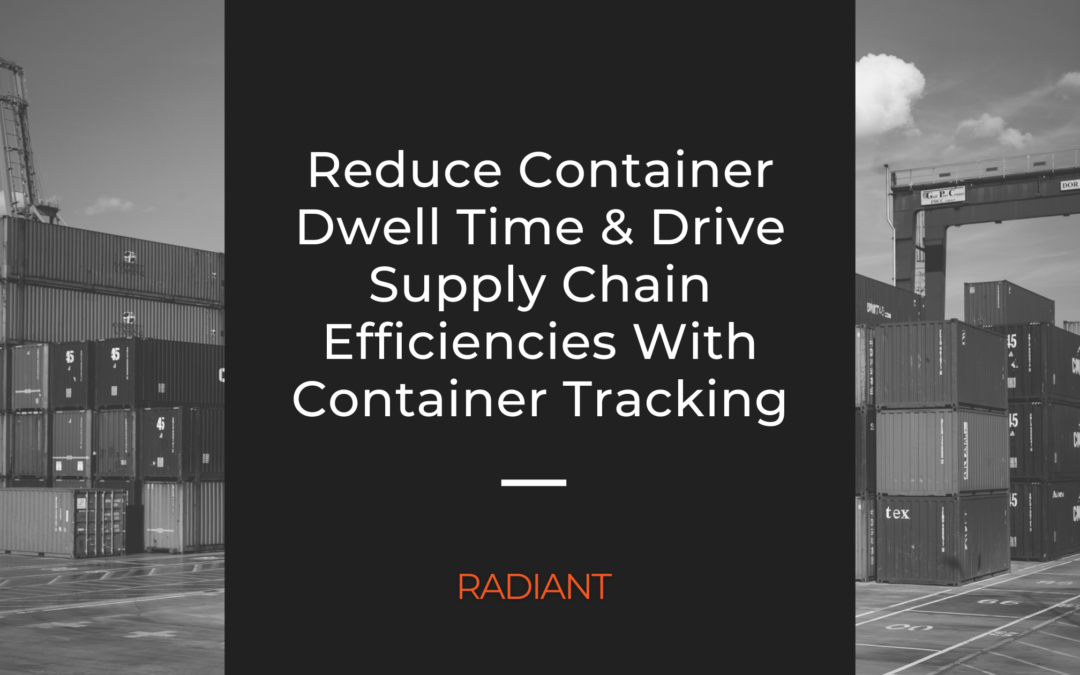One of the biggest issues facing global supply chains today is container dwell time. Containers often spend more time in transit than necessary, delaying the entire supply chain process.
By tracking containers using an IoT asset tracking solution, you can reduce container dwell time and improve supply chain performance. Here’s how…
What is Container Dwell Time?
Container dwell time is the amount of time that a container spends at a particular location.
For example, if a container arrives at a port and is then unloaded and stored at a nearby warehouse, the container’s dwell time would be the amount of time that it spends at the warehouse.
Container dwell time can be affected by many factors, including the efficiency of warehouse management, the unloading process, the availability of storage space, and local traffic conditions.
In general, longer container dwell times can result in higher shipping costs, longer lead times, and lower levels of customer satisfaction. Therefore, organizations that rely on container shipping often strive to minimize their container dwell times.

The Impact of Container Dwell Time on Supply Chain Efficiency
While container dwell time may seem like a relatively innocuous part of the supply chain, it can actually have a significant impact on supply chain efficiency in the long run. In fact, even a small increase in container dwell time can lead to significant delays further down the supply chain.
For example, if containers are held at the port for an extra day, it could delay order processing and the delivery of goods by several days. As a result, it is important for supply chain managers to closely monitor container dwell times and take steps to minimize delays.
There are many ways to do this, such as investing in container tracking technologies that provide real-time data to better forecast demand. By taking proactive measures to reduce container dwell time, supply chain managers can help ensure that goods are delivered on time and in good condition.
What is Container Tracking?
Container tracking is the process of monitoring the location and status of cargo containers as they move through the supply chain. Tracking information can be collected using a variety of technologies, including BLE, GPS, RFID, and barcodes. This data is then used to provide updates on the whereabouts of individual containers.
There are many reasons why businesses may want to track their containers, including ensuring that shipments arrive on time and in good condition, preventing theft, and reducing lost or damaged goods. Container tracking can also help businesses to better understand their supply chains and optimize their operations.
By having effective supply chain visibility into where their containers are at all times, businesses can identify bottlenecks and delays, and make adjustments to their operations accordingly.
How to Reduce Container Dwell Time with Container Tracking
Container tracking can be used to reduce container dwell time in a number of ways.
First, it can be used to track container movements in real-time, allowing for better coordination of container pick-ups and drop-offs. This can help to ensure that containers are not sitting idle for long periods of time, which can lead to increased dwell times.
Second, container management software can be used to generate detailed reports on container activity. These reports can be used to identify bottlenecks and other issues that may be causing delays in container movements or e.
Finally, container tracking can be used to monitor container utilization rates. This information can be used to optimize container usage and minimize the need for storage space, both of which can help to reduce dwell times.
Additional Benefits of Container Tracking for Supply Chain Efficiency
Container tracking systems can offer many benefits to supply chain managers looking to improve efficiency.
In addition to reducing container dwell time, these solutions can also help to optimize routing and improve asset utilization. For instance, by providing real-time visibility into the location and status of containers, logistics managers can more effectively plan and coordinate their shipping operations.
It can also help to reduce administrative costs by automating data collection and tracking. And by providing actionable insights into supply chain trends and patterns, a container tracking solution can enable companies to make better-informed decisions about their operations.
Additionally, container tracking solutions can help to reduce the risk of lost or stolen assets. By providing visibility into the location of containers at all times, these solutions can help supply chain managers quickly identify and recover any missing returnable assets.
By tracking containers, businesses can develop an internal standard for efficient supply chain management. This standard can help businesses to optimize their inventory management and ensure that containers are being used in a way that minimizes waste and maximizes efficiency.
Ultimately, by helping to improve supply chain efficiency in multiple ways, a container tracking solution can help companies to save time and money.
Reduce Container Dwell Time & Improve Supply Chain Efficiency with Container Tracking
Minimized container dwell time is a critical yet often overlooked component of an efficient and effective supply chain. By reducing container dwell time, businesses can improve their bottom line and ensure that goods are delivered on time and as promised to customers.
While there are many ways to reduce container dwell time, we believe the best approach is through the use of container tracking technology. With our solution, you can not only track your containers’ real-time location but also receive alerts when containers fall behind schedule or deviate from the plan.
Request a demo below to see how our container tracking solution can help you achieve improved supply chain efficiency.
Last Updated on September 20, 2022 by Radiant

